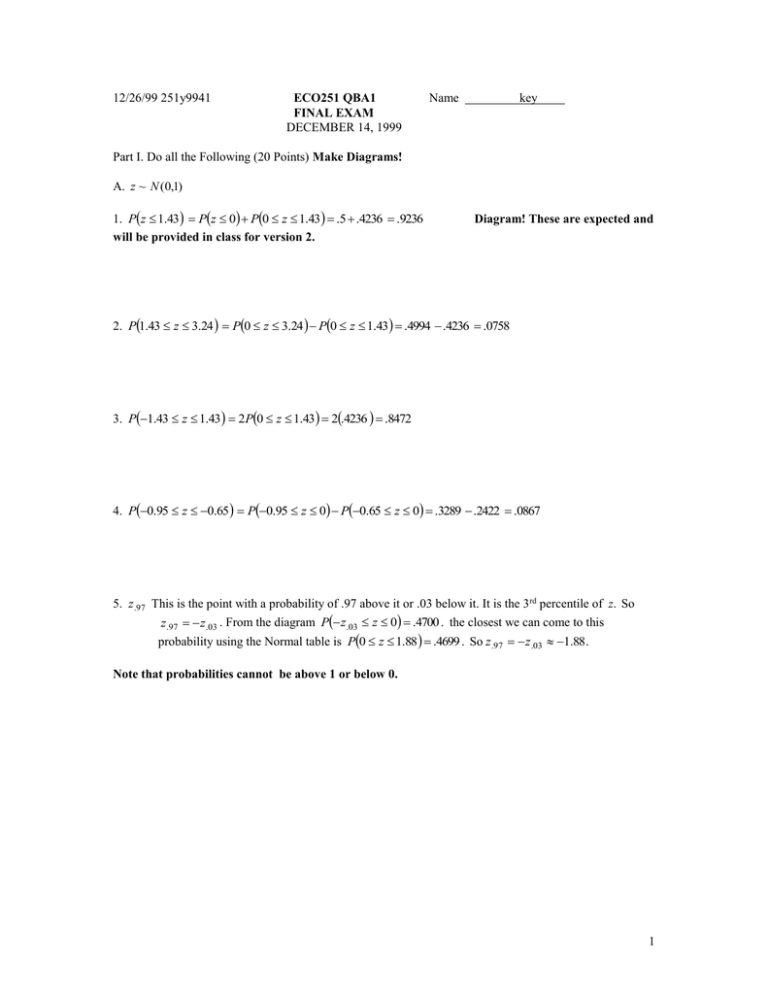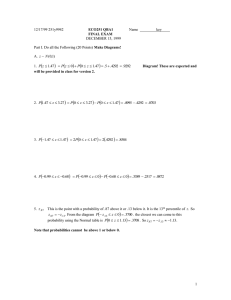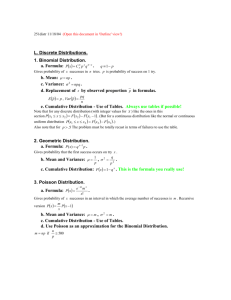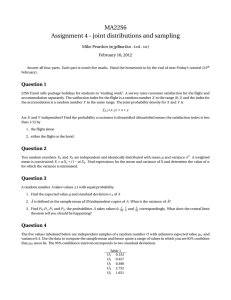advertisement

12/26/99 251y9941 ECO251 QBA1 FINAL EXAM DECEMBER 14, 1999 Name key Part I. Do all the Following (20 Points) Make Diagrams! A. z ~ N (0,1) 1. Pz 1.43 Pz 0 P0 z 1.43 .5 .4236 .9236 will be provided in class for version 2. Diagram! These are expected and 2. P1.43 z 3.24 P0 z 3.24 P0 z 1.43 .4994 .4236 .0758 3. P1.43 z 1.43 2P0 z 1.43 2.4236 .8472 4. P0.95 z 0.65 P0.95 z 0 P0.65 z 0 .3289 .2422 .0867 5. z .97 This is the point with a probability of .97 above it or .03 below it. It is the 3 rd percentile of z. So z.97 z.03 . From the diagram P z.03 z 0 .4700 . the closest we can come to this probability using the Normal table is P0 z 1.88 .4699 . So z .97 z .03 1.88 . Note that probabilities cannot be above 1 or below 0. 1 12/26/99 251y9941 B. x ~ N 1.5, 3 .As usual, people made diagrams of x with zero in the middle. Make up your mind! If you are diagramming x , put the mean in the middle; if you are diagramming z put zero in the middle. 1.43 1.5 1. Px 1.43 P z Pz 0.02 Pz 0 P 0.02 z 0 .5 .0080 .4920 3 x Remember z . 3.24 1.5 1.43 1.5 z 2. P1.43 x 3.24 P P 0.02 z 0.58 3 3 P0.02 z 0 P0 z 0.58 .0080 .2190 .2270 1.43 1.5 1.43 1.5 z 3. P 1.43 x 1.43 P P 0.98 z 0.02 3 3 P0.98 z 0 P0.02 z 0 .3365 .0080 .3285 0.65 1.5 0.95 1.5 z 4. P0.95 x 0.65 P P 0.82 z 0.72 3 3 P0.82 z 0 P0.72 z 0 .2939 .2642 .0297 5. x.97 This is the point with a probability of .97 above it or .03 below it. It is the 3rd percentile of x . Because it is below the 50th percentile, which is the mean for the Normal distribution, the point we want will be below 1.5. On the previous page we found z .97 z .03 1.88 . So x.97 z.97 1.5 1.883 4.14. 4.14 1.5 To check to see if this is correct: Px 4.14 P z Pz 1.88 3 Pz 0 P1.88 z 0 .5 .4699 .9699 .97 2 12/26/99 251y9941 II. (4 points-2 point penalty for not trying .) Show your work! A manufacturer of printheads investigates the amount of time before a printhead fails. The data for a sample of 8(in millions of characters)are below. x 1.5 1.4 1.2 1.6 1.3 1.3 1.4 1.5 Compute the sample standard deviation, s . Show your work. (4) Solution: Printhead lives x x2 1 1.5 2.25 2 1.4 1.96 3 1.2 1.44 4 1.6 2.56 5 1.3 1.69 6 1.3 1.69 7 1.4 1.96 8 1.5 2.25 11.2 15.80 x x 11.2 1.40 n 8 s x 0.017143 0.13093 x 15 .80 81.40 2 0.12 0.017143 n 1 7 7 s 0.13093 sx x 0.046291 n 8 s x2 2 nx 2 3 12/26/99 251y9941 III. Do at least 4 of the following 7 Problems (at least 12 each) (or do sections adding to at least 48 points Anything extra you do helps, and grades wrap around) . Show your work! 1. Using the sample standard deviation from the sample of 8 on the previous page a. Compute a 95% confidence interval for the mean time before a printhead fails. (4) b. Compute a 95% confidence interval for the mean time before a printhead fails assuming that the sample of 8 was taken from a batch of 80 printheads. (4) c. Compute a 95% confidence interval for the mean time before a printhead fails assuming that the population standard deviation is known to be 1.40 and the population is very large, but the sample size is still 8. (4) Solution: From the previous page x 1.40 , s x2 0.017143 , s x 0.13093 , s x s 0.046291 . n a) For a) and b) population variance is unknown, so we must use t instead of z. The general formula for a confidence interval is x tn1 s x . Here the degrees of freedom are n 1 8 1 7 and since the 2 7 confidence level is 95%, 1 .95 or .05 . Also tn1 t .025 2.365 . 2 From the previous problem - s x 0.017143 0.13093 sx sx 0.13093 n 0.046291 8 Putting this all together x tn1 s x 1.40 2.365 0.046291 1.40 0.1095 or 1.29 to 1.51. More formally, P1.29 1.51 .95 2 b) The population size, N 80 , is less than 20 times the sample size n 8 so s x N n N 1 sx n 80 8 0.046291 0.9546687 0.04419 and x tn1 s x 2 80 1 8 1.4 2.365 0.04419 1.4 0.1045 or 1.30 to 1.50. 0.13093 c) This time x 1.40 is known, so we can replace t with z z .025 1.960 . x 2 x n 1.40 0.4950 8 and x z x 1.4 1.960 0.4950 1.4 0.9702 or 0.43 to 2.37. 2 4 12/26/99 251y9941 2. The Freshman class at Chest Wester University has SAT Math scores that are normally distributed with a mean of 480 and a standard deviation of 60. a. What is the probability that a class of 36 will have a mean score below 476? (3) b. What is the probability that a person randomly picked from the Freshman class will have a score below 476? (2) c. Assuming that the class is quite large, what is the probability that 10 people picked randomly from the Freshman class will all have a score below 476? (2) d. What score would you have to have to be at the 95 th percentile of this class? (3) e. Create a symmetrical interval around 480 that contains 80% of the Freshman math scores. (2). f. What is the probability that, if I pick 10 people from the Freshman class, 8 or more of them will have scores above 480? (2) Solution: From the problem statement x ~ N 480 , 60 , i.e. 480, 60 and for the sample mean, x x n 60 10 . 36 476 480 a) Px 476 P z Pz 0.40 Pz 0 P 0.40 z 0 .5 .1554 .3446 10 476 480 b) Px 476 P z Pz 0.07 Pz 0 P 0.07 z 0 .5 .0279 .4721 60 c) Binomial probability of 10 out of 10 when p .4721 is .4721 10 5.4997 10 4 .00054997 . d) From the t table z .05 1.645 . So x.05 z.05 480 1.645 60 578 .70. e) From the t table z .10 1.282 . So x z 480 1.28260 480 76.82 or 404.08 to 556.92. f) Since the probability of being above the mean is .5, this is a binomial problem with n 10, p .5. Px 8 1 Px 7 1 .94531 .05469 . 5 12/26/99 251y9941 3. 10% of the patients at my hospital are dissatisfied with their experience. Last Monday 20 patients were discharged. All filled out surveys. a. In this group of 20, what was the mean and variance of the number that were dissatisfied? (2) b. What was the probability that over half of those discharged were dissatisfied? (2) c. What was the probability that at least one was dissatisfied? (2) d. If, instead, 55% of my patients were dissatisfied, what is the probability that at least half of the group of 20 would be dissatisfied? (2) e. If 55% of my patients were dissatisfied, what is the chance that at least one of the group of 20 would be dissatisfied? (2) f. If 55% of my patients were dissatisfied, and 200 were discharged in one day, what is the probability that at least half would be dissatisfied? (Don’t answer yet!) (i) Can this problem be done using the Poisson distribution? Why? If it can be done using the Poisson distribution, do it! (2) (ii) Can this problem be done using the Normal distribution? Why? If it can be done using the Normal distribution, do it! (3) Solution: Binomial p .10, n 20. a) np 20.10 2.0. 2 npq 2.0.90 1.80 b) Px 10 1 Px 10 1 1.00000 0 c) Px 1 1 Px 0 1 .12158 .87842 d) 10 or more successes when p .55, n 20 is 10 or fewer failures when the probability of failure is .45. Px 10 .75071 . e) The probability of one being satisfied is .45. The probability that all are satisfied is .45 20 1.16 10 7 . So the probability that at least one is not satisfied is 1 .45 20 1 1.16 10 7 .999999884 . To use the table to do this, reason that if at least one is not satisfied, not all are satisfied. Look up Px 20 Px 19 1.0000 for p .45, n 20 . f) (i) You cannot use the Poisson distribution since n 200 363 .63 is below 500. p .55 (ii) You can use the Normal distribution because np 200 .55 110 5 and nq 200 110 90 5 . 2 npq 110.45 49.5. Without continuity correction 100 110 Pz 1.42 Pz 0 P 1.42 z 0 .5 .4222 .9222 . Px 100 P z 49 .5 Or with the continuity correction, 99 .5 110 Pz 1.49 Pz 0 P 1.49 z 0 .5 .4319 .9319 Px 99 .5 P z 49 .5 6 12/26/99 251y9941 4. n 9 observations of the velocity x that at which a ball is thrown and the distance y that it is hit are reported below.(Ab p9-34) Note that all the sums are computed for you. Do not compute any other sums when doing this problem. Find the covariance and correlation between the velocity of the pitch and the distance the ball goes. (7) a) Interpret the correlation. What does this mean about the likelihood that a given hit will be a home run? (2) b) A sample is taken in another stadium. It is identical to the numbers shown here except all the distances are 5 feet longer. What would the new covariance and correlation be? (3) x x2 y xy y2 327 20 106929 400 6540 335 30 112225 900 10050 340 40 115600 1600 13600 348 50 121104 2500 17400 356 60 126736 3600 21360 363 70 131769 4900 25410 370 80 136900 6400 29600 378 90 142884 8100 34020 388 100 150544 10000 38800 3205 540 1144691 38400 196780 Solution: xy 196780 sxy x x 540 60 , y y 3205 356 .11111 , n 9 n y sx2 xy nx y 196780 960 356 .11111 4480 560 n 1 x 2 nx 2 n 1 9 1 8 38400 960 2 6000 750 ( s x 8 8 750 27 .38613 ) 9 1144691 9356 .11111 2 3354 .8960 419 .36200 n 1 8 8 s xy 560 ( s y 419.36200 20.47833) rxy .9971 sx s y 750 419 .36200 s 2y 2 ny 2 It is still true that a correlation cannot be above 1 or below –1! a) The positive sign of rxy , the sample correlation, indicates that x and y tend to move closely together. If we square rxy , we get approximately .994, which on a zero to one scale indicates a very strong relationship. This means that the faster the pitch, the more likely that a hit will be a home run. b) We are leaving x alone, but replacing y by y 5 . From the syllabus supplement and the outline if w ax b 1x 0 and v cy d y 5 so that a 1 and b 0 , c 1 and d 5 , wv Cov(ax b, cy d ) acCov( x, y) 11560 560 . (Unchanged) Corrw, v rwv signacrxy sign11.9970 sign 1.9971 .9971 (Unchanged) 7 12/26/99 251y9941 5. a) Two events A1 and B1 are independent. P A1 .3 , PB1 .2 Find the following. (i) Can A1 and B1 be mutually exclusive? Why? (1) (ii) P A1 B1 (1) (iii) P A1 B 1 (1) (iv) P A1 B1 (2) b) Now assume that A1 is independent of B1 , B 2 and B 3 , A2 is independent of B1 , B 2 and B 3 , and A3 is independent of B1 , B 2 and B 3 . P A2 .3 , PB2 .2 , that A1 , A2 and A3 are mutually exclusive and collectively exhaustive relative to one another, and that B1 , B 2 and B 3 are mutually exclusive and collectively exhaustive relative to one another. Fill in the joint probability table below.(3) B1 B 2 B3 A1 .... .... .... A2 .... .... .... A3 .... .... .... c) Now assume that a machine has two components. A1 is the probability that component 1 fails in period 1, A2 is the probability that component 1 fails in period 2 and A3 is the probability that component 1 fails in period 3. B1 is the probability that component 2 fails in period 1, B 2 is the probability that component 2 fails in period 2 and B 3 is the probability that component 2 fails in period 3. Assume that the machine works as long as any one component works. (i) If event A1 B1 occurs, during which period will the machine go down? (1) What about event A1 B2 ? (1) Find the probability that the machine goes down in period 1(1), period 2 (2) and period 3 (2). Use the joint probability table that you created in b). Solution: a) Two events A1 and B1 are independent. P A1 .3 , PB1 .2 . . (i) A1 and B1 cannot be mutually exclusive? Briefly, no two possible events can be both. If A1 and B1 are mutually exclusive P A1 B1 0 but see (ii) below. (ii) If A1 and B1 are independent P A1 B1 P A1 PB1 .3.2 .06 . (iii) If A1 and B1 are independent, by definition P A1 B1 P A1 .3 (iv) P A1 B1 P A1 PB1 P A1 B1 .3 .2 .06 .44 b) Because A1 , A2 and A3 are mutually exclusive and collectively exhaustive relative to one another, and P A1 .3 and P A2 .3 , P A3 1 P A1 P A2 1 .3 .3 .4 . Similarly, if B1 , B 2 and B 3 are mutually exclusive and collectively exhaustive relative to one another and PB1 .2 and PB2 .2 , then PB3 .6 . Because of the independence assumption, the numbers in the joint probability table will be B1 B 2 B3 A1 .06 .06 .18 .3 the product of the marginal probabilities. A2 .06 .06 .18 .3 . A3 .08 .08 .24 .4 .2 .2 .6 1.0 8 12/26/99 251y9941 c) Because the machine works as long as the longest lived component works, the event A1 B1 downs the machine in period 1, but the event A1 B2 downs the machine in period 2. So the various joint events down the machine as follows: Event A1 B1 A1 B2 Period Probability 1 .06 2 .06 3 .18 A1 B3 2 .06 A2 B1 2 .06 A2 B2 3 .18 A2 B3 3 .08 A3 B1 3 .08 A3 B2 3 .24 A3 B3 So PPeriod 1 P A1 B1 .06 PPeriod 2 P A1 B2 P A2 B1 P A2 B2 .06 .06 .06 .18 or PPeriod 2 1 PPeriod 1 PPeriod 3 1 .06 .76 .18 PPeriod 3 P A1 B3 P A2 B3 P A3 B1 P A3 B2 P A3 B3 .18 .18 .08 .08 .24 .76 or PPeriod 3 P A3 B3 P A3 PB3 P A3 B3 .6 .4 .24 .76 Note that, since no component lasts beyond period 3, these three probabilities must add to one. 9 12/26/99 251y9941 6. a. A professor has a pool of 20 multiple choice questions involving discrete probability distributions. Five of these questions involve the Hypergeometric distribution. Assume that he picks 6 questions at random to put on a quiz. What is the probability that at least one concerns the Hypergeometric distribution? (3) b. What is the mean and variance of the number of questions that concern the Hypergeometric distribution on the above quiz? (2) c. What would the answer to the above be if the pool of questions contained over 120 questions but the proportion that involve the Hypergeometric distribution was the same as in a)? Do not use the same distribution as you used in a).(2) d. A student has not studied for the above six-question quiz. Each multiple-choice question has four answers and she picks one randomly. What is the chance that she will get at least four right? (2) e. A student is extremely well-prepared for an exam. Nevertheless she knows that since she is tired she will make an average of .1 mistake per page. The exam is 6 pages. What is the probability that she will turn in a perfect exam? (2) f. In the exam in e, the professor takes off 2 points for each mistake. What is the variance of the number of points he will take off on her exam? (2) Solution: a) Hypergeometric N 20, M 5, n 6. Px q 1 p .75. Px 1 1 P0 1 C 05 C 615 C 620 C xM C nNxM C nN . p M 5 .25 N 20 15! 15 14 13 12 11 10 9!6! 6 5 4 3 2 1 1 1 1 .129127 .8709 20! 20 19 18 17 16 15 14!6! 6 5 4 3 2 1 1 N n 20 6 14 npq 6.25 .75 1.125 .8289 N 1 20 1 19 c) Since there was some vagueness in this question, either of the two following answers were accepted – 3 points was given for an answer to both. Binomial p .25, n 6. The rule of thumb for replacing the Hypergeometric by the binomial is that the population should be 20 times the sample. (i) From the binomial table, p .25, n 6. Px 1 1 P0 1 .00317 .99683 b) np 6.25 1.5, 2 (ii) np 6.25 1.50, 2 npq 6.25.75 1.125 d) p .25, n 6. Px 4 1 Px 3 1 .9624 .0376 e) Poisson m 0.16 0.6 P0 .54881 f) Poisson m 0.6 2 Since Varax a 2Varx , Var2x 2 2 Varx 40.6 2.4 . Note that it is still true that probabilities cannot be above 1 or below 0. 10 12/26/99 251y9941 7. A soft drink machine dispenses an amount of beverage that is distributed according to the continuous Uniform distribution between 6.6 and 7.4 oz. a. What is the mean and variance of the number of ounces dispensed by the machine. (2) b. What is the probability that a given drink will contain more than 7.1 oz.? (2) c. What is the probability that a given drink will contain between 6.5 and 7 oz? (1) d. Using the results of a) and your knowledge of the distribution of the sample mean, if the machine is tested by being used 100 times, what is the mean and variance of x , the average amount of soft drink dispensed? (2) e. What is the probability that the sample mean in d) will exceed 7.02 oz.? (3) f. What is the probability that the total amount of liquid dispensed in 100 uses will exceed 700 oz.? (2) 710 oz.? (2) Solution: a) c d 6.6 7.4 7.0 2 2 0.08333 0.28878 2 d c2 7.4 6.62 12 12 0.8 2 0.0533 12 7.4 7.1 .3750 Make a diagram. 7.4 6.6 7.0 6.6 .50000 . c) P6.5 x 7.0 7.4 6.6 b) Px 7.1 d) x N , x and x 2 x n 0.0533 0.02309 or 7.0 and 100 0.0533 .000533 (The mean and variance come from a) ) 100 7.02 7.0 e) Px 7.02 P z Pz 0.87 Pz 0 P0 z 0.87 .5 .2794 .2206 .02309 f) (i) If 700 oz. are dispensed in 100 uses, the mean amount dispensed is 7.0. Since 7.0 is the mean and median of the distribution Px 7.0 .5 . (ii) If 710 oz. are dispensed in 100 uses, the mean amount dispensed is 7.1. Px 7.1 x2 n 7.1 7.0 P z Pz 4.33 Pz 0 P0 z 4.33 .5 .5000 0 .02309 11 12/26/99 251y9941 IV. Extra Credit 1. Find P5 x 10 when p .06 and n 200 using the normal distribution with a continuity correction. According to the criterion you were taught, was the correction needed? Explain. Try the problem without the correction. How much difference did it make? (5) 2. (p 84)In a hockey league the length of time elapsed before a winning goal is scored has an exponential distribution with a mean of 9 minutes. What is the probability that the winning goal is scored in 3 minutes or less? (2) 3. If a winning goal is not scored within 20 minutes, the game will be a tie. What is the probability of this happening? (2) Solution: 1) Binomial P5 x 10 when p .06, n 200 ., q 1 p .94 . To use the Normal distribution we require np 200 .06 12 5 and nq n np 200 12 188 5. In addition 2 npq 200.06.94 11.28 . Since the variance is above 9, a continuity correction is supposedly not needed. Without the continuity correction 5 12 10 12 P 2.08 z 0.60 .4812 .2257 .2555 P5 x 10 P z 11 . 28 11 . 28 . With the continuity correction 4.5 12 10 .5 12 P 2.23 z 0.45 .4871 .1736 .3135 P4.5 x 10 .5 P z 11 .28 11 .28 The error is about .06, about 1/5 of the result. This looks fairly large to me. 1 2) The Exponential distribution has F x 1 e cx where . For these problems c 1 1 c 0.1111 . 9 Px 3 F 3 1 e 0.11113 1 e 0.3333 1 .71653 .28347. 3) Px 20 1 Px 20 1 F 20 1 1 e 0.111120 e 2.2222 .10837. 12





